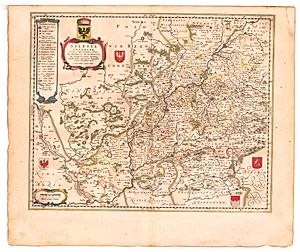Maria Cunitz facts for kids
Quick facts for kids
Maria Cunitz
|
|
|---|---|

A memorial to Maria Cunitz in Świdnica, Poland
|
|
| Born | 1610 Wohlau, Duchy of Legnica, Holy Roman Empire
|
| Died | 22 August, 1664 (aged 53–54) Pitschen, Duchy of Legnica, Holy Roman Empire
|
| Known for | Urania propitia |
| Spouse(s) |
David von Gerstmann
(m. 1623)Elias von Löwen
(m. 1630) |
| Children | Elias Theodor, Anton Heinrich and Franz Ludwig |
| Scientific career | |
| Fields | Astronomy, mathematics |
| Academic advisors | Elias von Löwen |
Maria Cunitz (born around 1610 – died August 22, 1664) was an amazing Silesian astronomer. She is known as one of the most important female astronomers of her time. Maria wrote a famous book called Urania propitia. In this book, she created new tables and a simpler way to figure out where planets would be in their orbits.
A crater on the planet Venus is named after her. Also, a small planet called 12624 Mariacunitia honors her name.
Contents
Maria Cunitz's Life and Education
Maria Cunitz was born in Wohlau (now Wołów, Poland). Her father, Heinrich Cunitz, was a doctor and landowner. Her mother, Maria Scholtz, was the daughter of a German scientist. The exact year Maria was born is not known for sure, but it was likely around 1610.
Maria did not go to a formal school. Instead, her parents taught her many subjects at home. She learned about mathematics, medicine, history, and the fine arts. Maria was very smart and could speak seven languages! These included German, Italian, French, Polish, Latin, Greek, and Hebrew.
When she was 13, Maria married a lawyer named David von Gerstmann. After he passed away in 1626, she married Elias von Löwen in 1630. Elias was a doctor and also loved astronomy. He was one of Maria's teachers and encouraged her to study the stars. Together, they observed planets like Venus and Jupiter. They had three sons: Elias Theodor, Anton Heinrich, and Franz Ludwig.
During the Thirty Years' War (1618-1648), Maria and Elias had to leave their home. They found safety in a convent in Olobok, Poland. While in hiding, Maria worked on her astronomical tables. She based them on the Rudolphine Tables by Johannes Kepler, but she made them easier to use.
After the war, they returned home. In 1650, Maria published her book Urania propitia. She paid for it herself. The book was written in both German and Latin.
Urania Propitia: Her Famous Book
Urania propitia is Maria Cunitz's most important work. It was a big book with many tables. These tables helped people find the exact location of planets in the sky.
Maria improved on Johannes Kepler's Rudolphine Tables. Kepler's tables were very hard to use because they involved complex math. Maria created simpler ways to do the calculations. This made it easier for other astronomers to use. She published her book in both Latin and German so more people could read it.
Maria's husband, Elias von Löwen, wrote the introduction to Urania propitia. He wanted everyone to know that the book was completely Maria's own work. He made it clear that he only supported her and did not write any part of it himself.
Urania propitia offered new tables and a better way to solve Kepler's Problem. This problem is about figuring out a planet's position in its orbit over time. Her book also helped develop the German language used in science.
The book's title, Urania propitia, means "Urania, the beneficent." Urania is the Greek goddess of Astronomy. This title showed the connection between the goddess and Maria, the female author. It was a powerful statement at a time when there were few recognized women scientists.
Maria Cunitz's Legacy
Maria Cunitz's work had a lasting impact on astronomy. It inspired other astronomers to make their calculations simpler and more accurate.
Sadly, a fire in Byczyna, Poland, destroyed Maria and Elias's home. They lost many valuable things, including Maria's astronomy tools, books, papers, and letters. Much of her work was lost forever.
However, Urania propitia was published privately, and some copies still exist today. As of 2016, there are nine physical copies around the world. You can find them in libraries like the Astronomical Observatory of Paris and the University of Florida. One copy was sold at an auction for over $19,000!
In Świdnica, the town where Maria grew up, there is a special monument to her. It's an iron bench with a bronze statue of Maria sitting on it, holding her book Urania propitia. This is the only known monument dedicated to Maria Cunitz.
Her Background
Maria Cunitz is often described as Silesian. Silesia is a region that has changed hands many times throughout history. During Maria's life, it was part of the Holy Roman Empire.
In Maria's time, a person's nationality was not as important as it is today. However, where she lived and the effects of the Thirty Years' War did influence her work. Her time in hiding helped her create her simplified astronomical tables.
Later, people tried to give Maria Cunitz a nationality that fit their own time. She has often been called German, especially since she published her book in German. Some also consider her to be the first Polish woman astronomer. Maria spoke many languages, including German and Polish.
See also
 In Spanish: Maria Cunitz para niños
In Spanish: Maria Cunitz para niños


